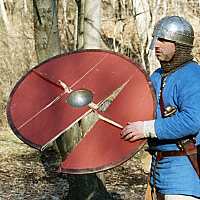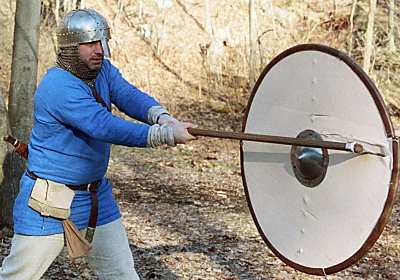| Author |
Message |
|
T. Brandt
|
 Posted: Sun 30 Aug, 2015 4:52 pm Post subject: A leather gambeson that functions as well as a linen one? Posted: Sun 30 Aug, 2015 4:52 pm Post subject: A leather gambeson that functions as well as a linen one? |
 |
|
I've done some looking around, and as I'm not a materials science expert, I can't say I follow the deep math--but from a post here on myArmoury, there was mention of, by weight, linen being a better option than leather for armor.
So, I have a proposition: what of layering different pieces of leather, with the outermost layer being the stiffest (not boiled-stiff, though), gradually getting to a linen or cotton level of softness via the innermost layer. So you have the initial hard stop at the beginning, and then the shock absorption of the soft.
Or, conceivably, having an even more complex model by alternating hard-soft-hard-soft in your layering, still gradually moving towards soft as you layer inwards.
Now sure, you could say "if you have that much leather and that much time, make a laminar/lamellar combination armor," but hey- I'm curious.
|
|
  |
 |
|
Houston P.
Location: United States Joined: 20 Apr 2015
Posts: 83
|
 Posted: Sun 30 Aug, 2015 5:44 pm Post subject: Posted: Sun 30 Aug, 2015 5:44 pm Post subject: |
 |
|
To my understanding leather doesn't offer much resistance against piercing attacks, so I would imagine that arrows and thrusts would have a much easier time penetrating it than an ordinary gambeson. I also am not sure if it would offer much resistance to cuts, as I know boiled leather can reportedly stop them, but without that it kind of loses all of the potential usefulness of leather. It would also probably be much less maneuverable than an ordinary gambeson. I'm certainly no expert but I can't imagine it being very capable protection.
...and he that hath no sword, let him sell his garment, and buy one. (Luke 22:36)
|
|
  |
 |
|
Philip Dyer
|
 Posted: Sun 30 Aug, 2015 7:14 pm Post subject: Posted: Sun 30 Aug, 2015 7:14 pm Post subject: |
 |
|
| Houston P. wrote: | | To my understanding leather doesn't offer much resistance against piercing attacks, so I would imagine that arrows and thrusts would have a much easier time penetrating it than an ordinary gambeson. I also am not sure if it would offer much resistance to cuts, as I know boiled leather can reportedly stop them, but without that it kind of loses all of the potential usefulness of leather. It would also probably be much less maneuverable than an ordinary gambeson. I'm certainly no expert but I can't imagine it being very capable protection. |
The leather skin on a stiff gambeson was done historically in Highland Scotland and Ireland. It is called a Cotun. It was typically a very thick gambeson covered in deerskin and tar to make the whole garment waterpoof. If you wanted to make it fireproof, just do the same thing people did with buff coats. I would guess that a gambeson with a leather skin would be slightly better at absorbing shock. baseball catchers and umpires used leather gloves and chest protection for a reason. But yeah, the cotun was very thick and stiff. http://www.stoccata.org/index.php/resources/a...land-coutn So stiff that it can't really cover the armpits if you want full mobility of your arms.
|
|
  |
 |
|
T. Brandt
|
 Posted: Sun 30 Aug, 2015 8:23 pm Post subject: Posted: Sun 30 Aug, 2015 8:23 pm Post subject: |
 |
|
Hm... alright, another question.
Out of the possible materials-- linen, cotton, wool-- which are considered the best material out of which to make a gambeson? What is considered to be the best stuffing? Does the "softer fiber is better" approach to stuffing actually work, or is it more complex than that?
Second--and now we're getting speculative--I've noticed a few examples of, say, a wooden shield covered with leather, or with canvas. Is there any mention of having a wooden surface covered with leather or canvas making a meaningful difference in a shield's performance?
I mean, in my untrained mind, a (relatively) small shield made of three layers-- thin metal backing/frame, wooden main body, and leather covering would provide a more rounded defense (having both the soft and the hard), but that's pure speculation. We could start getting into something like buffalo/bison leather vs. cow leather, but... that's a little beside the point.
|
|
  |
 |
|
Mart Shearer
|
 Posted: Sun 30 Aug, 2015 11:48 pm Post subject: Posted: Sun 30 Aug, 2015 11:48 pm Post subject: |
 |
|
There are two broad categories of textile armors, the semi-rigid and soft. Historic documents find supporters of both camps.
For example, the regulation from Louis XI (1461-1483) calls for a jack of layered linen covered with deerskin.
| Quote: | | Et premičrement leur faut desdit Jacques de 30 toilles oł de 25 a ung cuir de cerf ą tout le moins; et si sont de 31 cuir de serf ils sont des bons. |
And first there wants for those Jacks 30 or 25 cloths, and a buck-skin at least, and if they be of 30 and a buck skin they are best.
(It should be noted that buckskin was usually quite stretchy, and not a "rigid" leather.)
Report of England made by Giovanni Michiel, late Ambassador to Queen Mary and King Philip, to the Venetian Senate, on the 13th May 1557.
| Quote: | | ma l' uso pił frequente č di alcuni giubboni di canevaccio imbottiti a molti doppj alti due dita e pił riparo tenuto sicurissimo contro la furia delle freccie |
but the most commonly used are some padded canvas jupons, many of double thickness, two fingers high; which are considered more resistant to the fury of arrows
Also, Dominic Mancini (1482-1483)
| Quote: | | Vulgus vero militum tunicas habet aptiores, infra inguen demissas, stupa sive alia molli referctas. |
The masses of soldiers have fitted tunics, which fall below the groin, which carry tow or other soft material.
There are historic document calling for stuffing aketons, gambesons, etc. with cotton (cotton wool), linen tow, rags, etc.. One legal complaint against falsely selling stuffed mattresses, saddles, and so forth mentions some of the materials used for stuffing including wool flocks, cattails, thistledown, Tanners (felt), so it seems most soft materials might find their way into some hidden stuffing unless regulators were present.
The 1322 London Armourer's regulation allows for a fancy cover over a fabric shell.
| Quote: | | That a haketon and a gambeson covered with sendale, or with cloth of silk, shall be stuffed with new cotton cloth, and with cadaz, and with old sendales, and in no other manner. And that white haketons shall be stuffed with old woven cloth, and with cotton, and made of new woven cloth within and without. |
Sendale: OF cendal > L sindon > Gr sindon, σινδών, possibly a fine bleached linen.
Cadaz: 1. (n) caddis Flock or wadding of any fibrous material for stuffing, bombasting, and the like, used in the fifteenth century and later. 2. (n) caddis A kind of lint for dressing wounds.
ferrum ferro acuitur et homo exacuit faciem amici sui
|
|
  |
 |
|
Mart Shearer
|
 Posted: Mon 31 Aug, 2015 12:02 am Post subject: Posted: Mon 31 Aug, 2015 12:02 am Post subject: |
 |
|
| T. Brandt wrote: | | Second--and now we're getting speculative--I've noticed a few examples of, say, a wooden shield covered with leather, or with canvas. Is there any mention of having a wooden surface covered with leather or canvas making a meaningful difference in a shield's performance? |
Most extant medieval shields have that facing glued over the wood.
Think of it in modern terms, where BMW overlays carbon fiber fabric over plastic on it's i3 car, or boat builders laminate fiberglass fabric over wood to add strength.
Towards the bottom of this page, you can see the difference a fabric or leather facing can make.
http://www.hurstwic.org/history/articles/manu...hields.htm
Plank shield after 2 ax blows:

2oz. leather-faced plank shield after 4 ax blows:

ferrum ferro acuitur et homo exacuit faciem amici sui
|
|
  |
 |
|
William P
|
 Posted: Mon 31 Aug, 2015 7:23 am Post subject: Posted: Mon 31 Aug, 2015 7:23 am Post subject: |
 |
|
|
it's also worth noting that canvas facing for shields is considerted standard for most reenactors and even 1-2 layers of moderately tough canvas glued on make a world of difference to the durability of the wood underneath
|
|
   |
 |
|
|
You cannot post new topics in this forum
You cannot reply to topics in this forum
You cannot edit your posts in this forum
You cannot delete your posts in this forum
You cannot vote in polls in this forum
You cannot attach files in this forum
You can download files in this forum
|
All contents © Copyright 2003-2025 myArmoury.com — All rights reserved
Discussion forums powered by phpBB © The phpBB Group
Switch to the Basic Low-bandwidth Version of the forum
|

